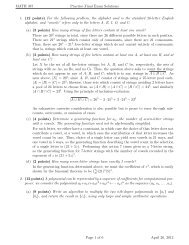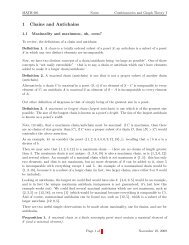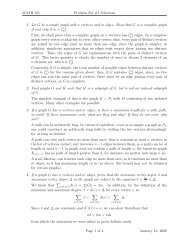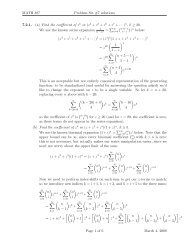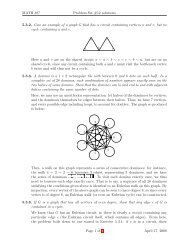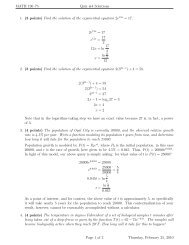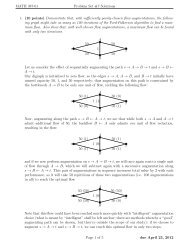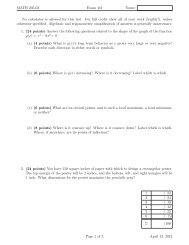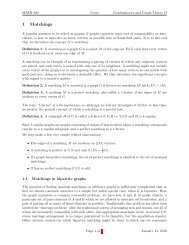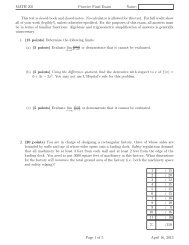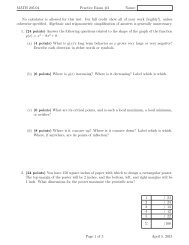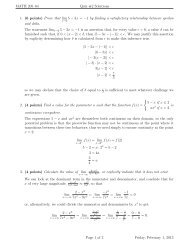MATH 205 Final Exam Solutions Name: 1. (12 points) The keratoid ...
MATH 205 Final Exam Solutions Name: 1. (12 points) The keratoid ...
MATH 205 Final Exam Solutions Name: 1. (12 points) The keratoid ...
Create successful ePaper yourself
Turn your PDF publications into a flip-book with our unique Google optimized e-Paper software.
<strong>MATH</strong> <strong>205</strong> <strong>Final</strong> <strong>Exam</strong> <strong>Solutions</strong> <strong>Name</strong>:<br />
1<br />
(c) (4 <strong>points</strong>) Evaluate lim t→∞ or demonstrate that it cannot be evaluated.<br />
t 2 e t<br />
As t gets very large, the denominator of this expression will get very large while the<br />
numerator is a constant 1; as a result, the limit is 0.<br />
9. (<strong>12</strong> <strong>points</strong>) A sentry at Blackgate Prison has turned a spotlight on an escapee who is currently<br />
0.3 miles to the north and 0.4 miles to the east of the prison. She notices that the escapee is<br />
traveling eastwards at four miles per hour.<br />
(a) (6 <strong>points</strong>) How quickly will she need to rotate the spotlight to keep it trained on the<br />
escapee?<br />
Let the angle of the spotlight from true north be called θ, and let the distance the fugitive<br />
is to the east of the prison be called x. Since the fugitive is a constant distance 0.3 to the<br />
north of the prison, and a distance x easy of the prison, drawing a right triangle makes it<br />
clear that tan θ = x . 0.3<br />
We know that x is currently 0.4, and that dx = 4¡ so we may use related-rates techniques<br />
dt<br />
to determine dθ , differentiating each side of the above relationship with respect to t:<br />
dt<br />
d<br />
dt tan θ = d x<br />
dt 0.3<br />
dθ<br />
dt<br />
d<br />
dθ tan θ<br />
dx<br />
= dt<br />
dθ<br />
0.3 dt sec2 θ =<br />
dx<br />
dt<br />
dθ<br />
0.3 dt<br />
=<br />
dx<br />
dt cos2 θ<br />
0.3<br />
and since θ is in a right triangle adjacent to a side of length 0.3 and with hypotenuse 0.5,<br />
we may specifically expand that to<br />
in radians per hour.<br />
dx<br />
dθ<br />
dt = dt cos2 θ<br />
0.3<br />
= 4 ( )<br />
0.3 2<br />
0.5<br />
0.3<br />
= <strong>1.</strong>2<br />
0.25 = 4.8<br />
(b) (6 <strong>points</strong>) How quickly is the escapee’s distance from the prison changing?<br />
d<br />
dt (0.32 + x 2 ) = d dt (s2 )<br />
dx d<br />
dt dx (x2 ) = ds d<br />
dt ds (s2 )<br />
dx ds<br />
(2x) =<br />
dt dt (2s)<br />
x dx<br />
dt<br />
s<br />
= ds<br />
dt<br />
And since x and s have current values of 0.4 and 0.5 respectively, ds<br />
dt = 0.4·4<br />
0.5 = 3.2<br />
10. (<strong>12</strong> <strong>points</strong>) Answer the following questions:<br />
(a) (4 <strong>points</strong>) Find ∫ d e t<br />
dt. dt t<br />
We know that in general ∫ d<br />
f(t)dt = f(t) + C, so in this case, ∫ d<br />
dt dt<br />
e t et<br />
dt = + C.<br />
t t<br />
(b) (4 <strong>points</strong>) Find d<br />
dx arctan x2 −1<br />
x+2 . Page 5 of 6 November 30, 2011




